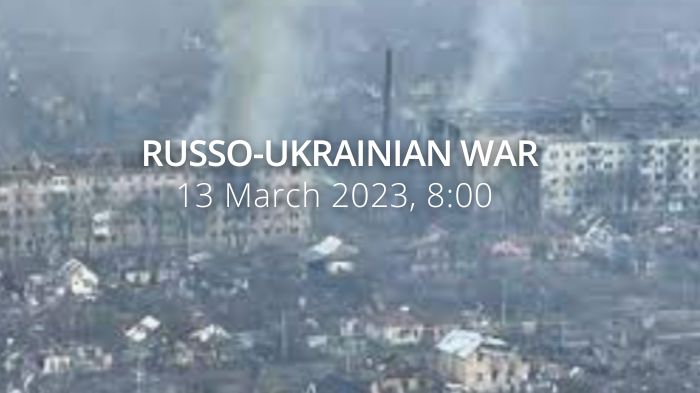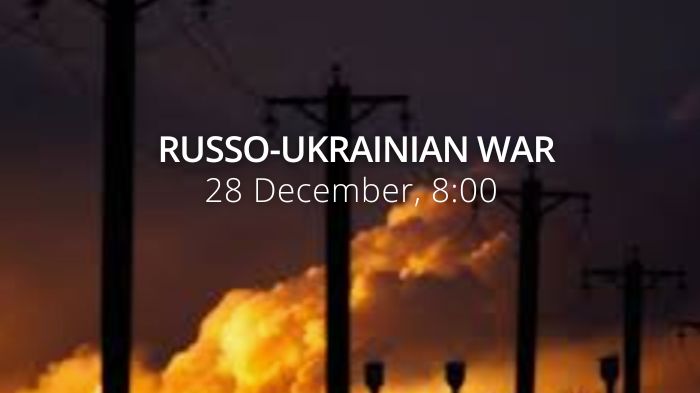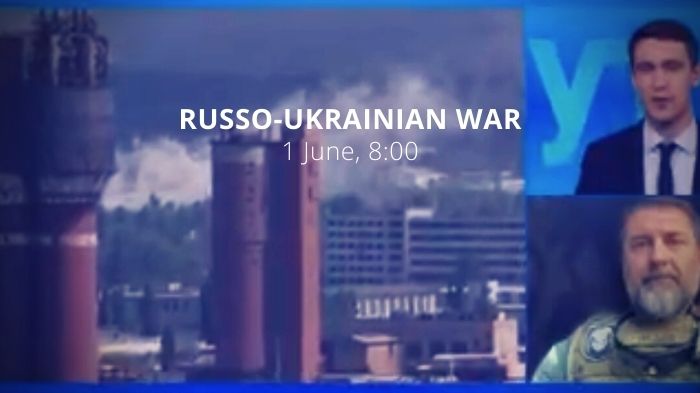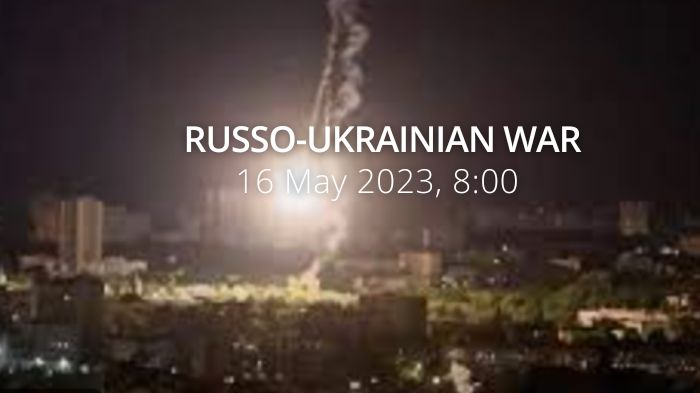General Staff says it is incorrect to assess how much of Soledar is under Ukraine’s control. Russians fail to break through the defense in Bakhmut direction. More than 2.4M Ukrainians live in war-damaged homes.
Inside Soledar, the site of heavy battles between Ukraine and Russia – in pictures
The city of Soledar in Ukraine’s eastern Donbas region has seen days of heavy fighting as Ukraine strives to repel Russian forces from around Bakhmuthttps://t.co/wAFNWum2Ff pic.twitter.com/fNuL6czJLS
— Euromaidan Press (@EuromaidanPress) January 12, 2023
Daily overview — Summary report, January 13, 2023
The General Staff’s operational update regarding the Russian invasion as of 18.00 pm, January 13, 2023 is in the dropdown menu below:
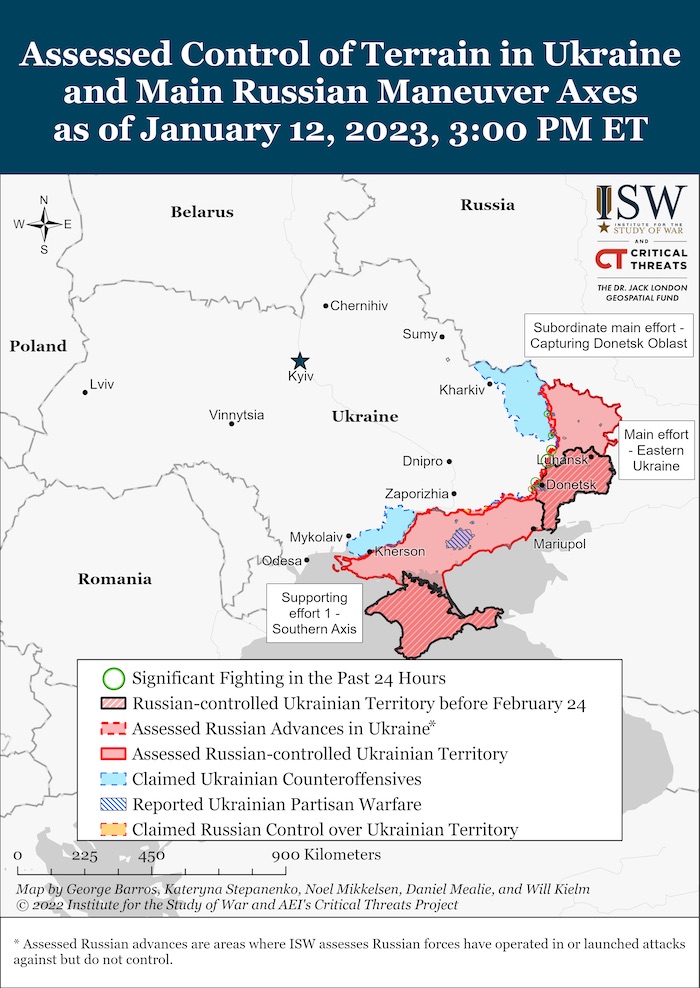
The adversary keeps focusing its main efforts on attempts to capture Donetsk oblast within its administrative border, and continues to advance on Bakhmut axis. The most fierce fighting is taking place in the vicinities of Soledar, Paraskoviivka, Bakhmut, and Klishchiivka.]
[Russian forces are conducting unsuccessfuloffensive operations on the Avdiivka axis, while on Kup’yans’k and Lyman axes, the invaders keep trying to improve their tactical situation. On Novopavlivka, Zaporizhzhia, and Kherson axes, the occupant forces are on the defensive.]
Over the past 24 hours, Ukrainian Defense Forces repelled attacks in the vicinities of Stelmakhivka, Makiivka and Bilohorivka (Luhansk oblast); Spirne, Rozdolivka, Sil’, Krasna Hora, Pidhorodne, Bakhmut, Klishchiivka, Predtechyne, Kurdyumivka, Vodyane, Nevels’ke, Krasnohorivka, Mariinka, and Velyka Novosilka (Donetsk oblast).
Russian occupiers launched 5 rocket attacks on the peaceful cities of Kostyantynivka, Kramatorsk and Zaporizhzhia. In addition, the occupiers carried out 52 MLRS attacks and 18 air strikes.
[The threat of air and missile strikes by Russian forces across Ukraine remains high.]
Volyn, Polissya, Sivershchyna and Slobozhanshchyna: no signs of the formation of an offensive grouping are reported. Certain units of the armed forces of Belarus and Russia stay in areas bordering Ukraine.
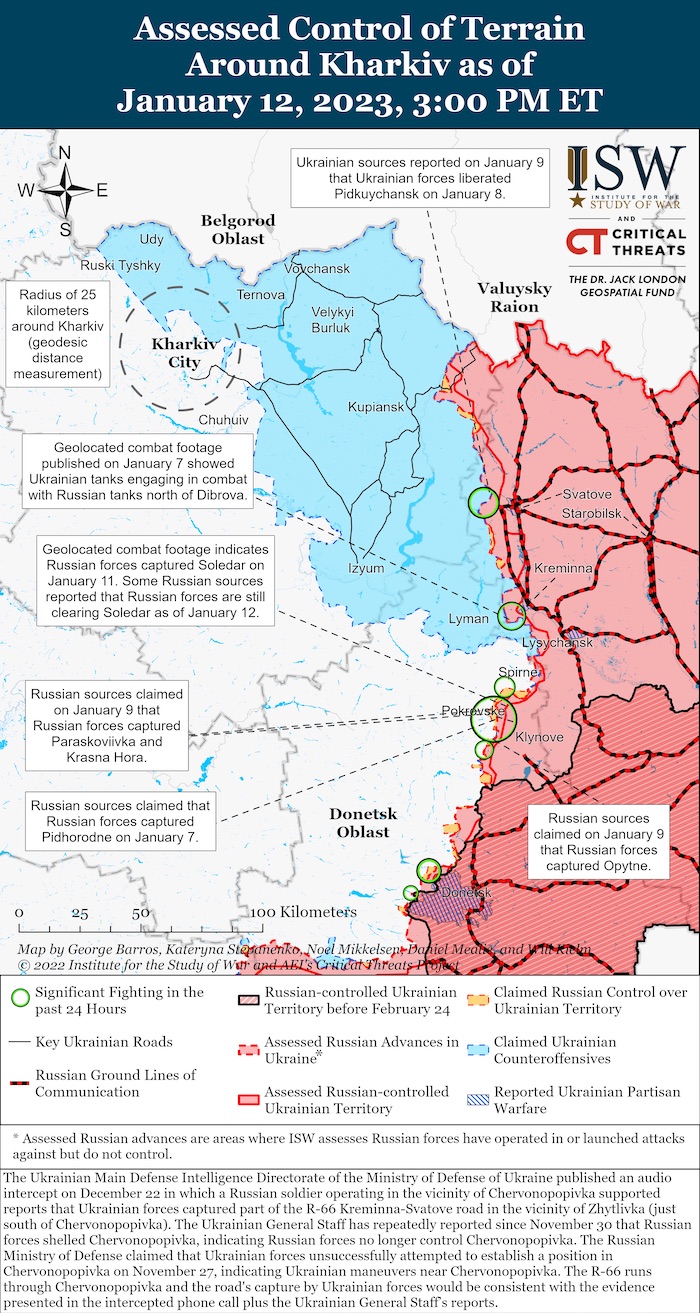
- Sivershchyna and Slobozhansk axes: the vicinities of Senkivka and Karpovichi settlements (Chernihiv oblast); Porokhon’ and Bachivs’k (Sumy oblast); as well as Strilecha, Zelene, Ternove, Starytsya, Ohirtseve, Hatyshche, Vovchansk, Chugunivka, and Ridkodub (Kharkiv oblast) came under fire.
- Kupiansk axis: the vicinities of Dvorichna, Zapadne, Synkivka, Orlyanka, Kislivka, Kotlyarivka, Kolisnyivka, Berestov, Bohuslavka, Ivanivka (Kharkiv oblast); and Stelmakhivka in Luhansk oblast suffered enemy attacks.
- Lyman axis: Russian forces shelled Hrekivka, Makiivka, Nevske, Chervonopivka, and Dibrova (Luhansk oblast).
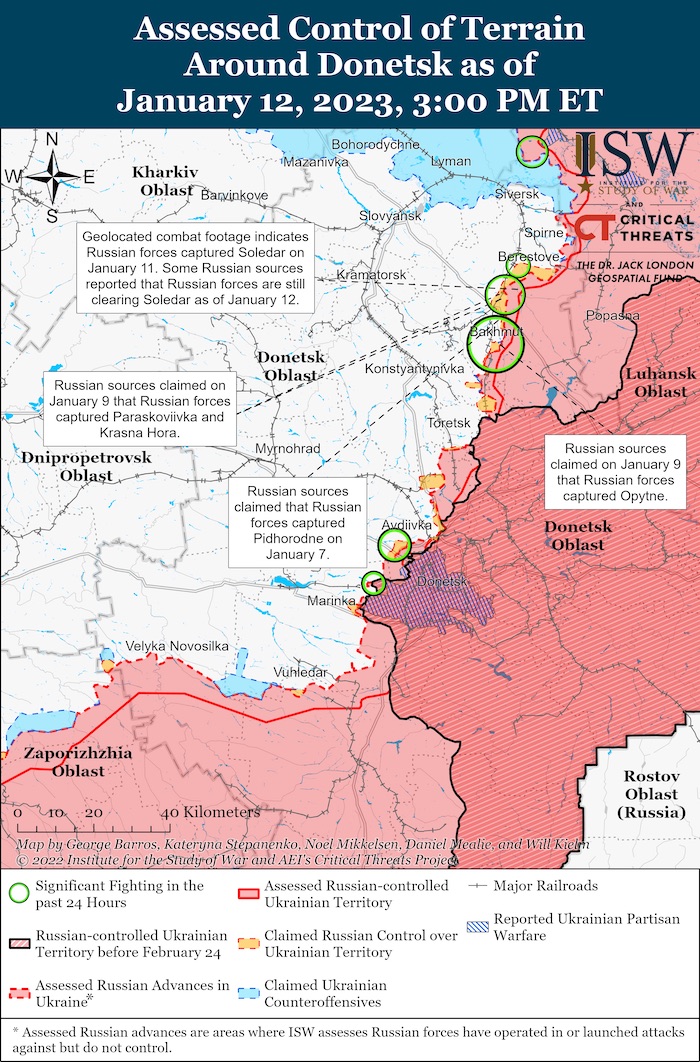
- Bakhmut axis: Spirne, Bilohorivka, Rozdolivka, Soledar, Krasna Hora, Paraskoviivka, Pidhorodne, Bakhmut, Klishchiivka, Kurdyumivka, Ozaryanivka, Druzhba, and Pivnichne (Donetsk oblast) were subject to enemy attacks.
- Avdiivka axis: Russian forces shelled Krasnohorivka, Avdiivka, Mariinka, and Novomykhailivka.
- Novopavlivka axis: Vuhledar, Prechistivka and Zolota Nyva (Donetsk oblast) came under enemy fire.
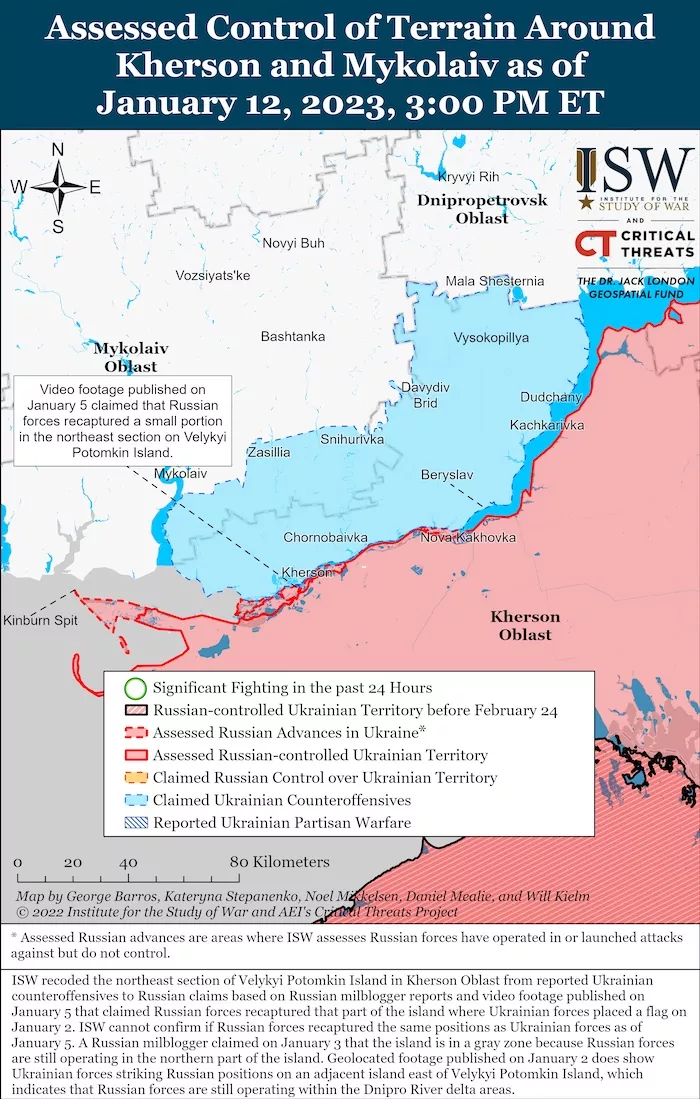
- Zaporizhzhia axis: Russian tanks, mortars, artillery and MLRS attacked the vicinities of Vremivka and Vilne Pole settlements (Donetsk oblast); Hulyaipole, Zaliznychne, Hulyaipil’s’ke, Chervone, Charivne, Biloghirya, Mala Tokmachka, Orihiv, and Kam’yans’ke (Zaporizhzhia oblast).
- Kherson axis: Antonivka and the city of Kherson were subject to enemy mortar and artillery fire.
The Russian occupiers continue to put pressure on local population of the temporarily occupied territories of Kherson oblast, who refuse to cooperate with the occupation authorities. In addition, the invaders are concerned about the pro-Ukrainian attitude of the citizens of the oblast, which poses a threat to them.
In some settlements of the Melitopol district of the Zaporizhzhia oblast, Russian forces are carrying out filtering actions. During the inspection, the occupiers pay special attention to phones, looking for confirmation of cooperation with the Defense Forces of Ukraine.
Following the available information, one of the Russian units, that operate in the vicinities of Novopavlivka and Volnovakha (Donetsk oblast), ordered civilian uniforms with “Rosneft” and “Elektrostal” logos for its personnel. Apparently, Russian forces are trying to hide the affiliation of its personnel with the Russian occupation forces for a certain purpose.
[Russian occupants continue to rob the local population on the temporarily occupied territory of Kherson oblast. In one of the settlements of Kakhovka district, the occupation authorities announced an inventory check of movable and immovable property of local private entrepreneurs, followed by the so-called “nationalization”.]
[To replenish its casualties, Russian forces does not stop mobilizing the male population, including in the temporarily occupied territory of Luhansk oblast. Thus, the beginning of the next wave of mobilization was reported in the city of Alchevsk on January 09, 2023.]
During the past day, Ukrainian Air Force conducted 16 airstrikes on concentrations of enemy troops and 5 air strikes on Russian anti-aircraft missile systems.
At the same time, our defenders shot down 1 enemy Su-25 attack jet and 1 “Orlan-10” UAV.
Ukrainian missile and artillery troops attacked 3 command posts, 12 concentrations of Russian troops and military equipment, 1 enemy S-300 anti-aircraft missile complex, 3 ammunition depots, and 3 other critical military targets.
Military Updates
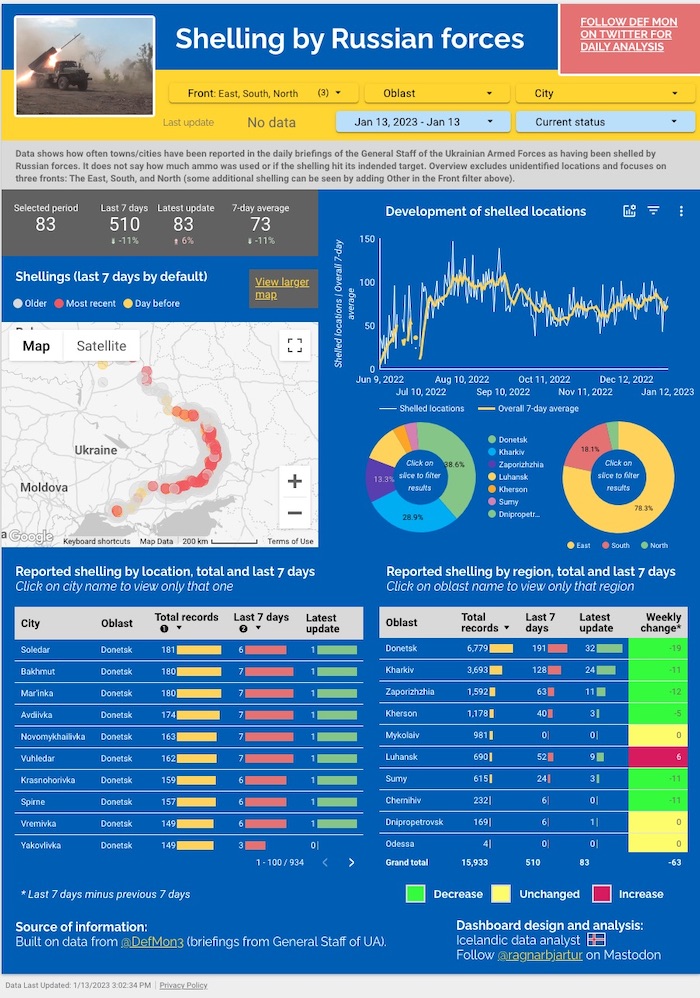
Russia is still far from capturing Bakhmut, lack of ammunition prevents invaders from advancing, Ukrainska Pravda reports, citing ISW. “Analysts from the Institute for the Study of War (ISW) believe that Russia is far from taking Bakhmut, as the ability of Russian troops to support offensive operations in Ukraine’s east in 2023 will be hampered by lack of ammunition and disorganisation among the troops.”
As Russians stopped using the airfield in Kherson's Chaplynka after it found itself within the range of the Ukrainian HIMARS, they established their helicopter base at the Berdiansk airfield about 100 km behind the lines. https://t.co/5PbtNVhUvf pic.twitter.com/EZOyxSHdjI
— Euromaidan Press (@EuromaidanPress) January 11, 2023
Russians fail to break through the defense in Bakhmut direction, Ukrinform reports, citing the spokesperson for the Eastern Grouping of the Armed Forces of Ukraine. Serhii Cherevatyi. “Generally, in the Bakhmut direction, enemy troops are trying to seize the initiative, making continuous assault attempts, but they are failing to break our defence and reach the rear, Cherevatyi told. In his words, 355 military clashes have occurred in the eastern direction over the past week. Forty-two clashes have taken place in the Bakhmut direction in the past 24 hours.
Unfortunately, Russian troops can still receive ammunition supplies. But, Ukraine’s Defense Forces are working to increasingly disrupt enemy logistics. Now, Russian invaders are forced to deliver ammunition supplies from farther positions, as Ukrainian forces destroy their field depots with artillery. According to Cherevatyi, Russian forces may occasionally achieve tactical successes, but heavy losses are leading to a systemic crisis in the invaders’ warfare.”
Ukrainian state-owned defense conglomerate Ukroboronprom launched serial production of 82-mm fragmentation shells at facilities of a NATO member state
"The number of its fragments is 2-2.5 times greater than the standard one's" Ukroboronprom sayshttps://t.co/c4xYvCHbNQ pic.twitter.com/AvFH8jbnoH
— Euromaidan Press (@EuromaidanPress) January 12, 2023
General Staff says it is incorrect to assess how much of Soledar under Ukraine’s control now, Ukrainska Pravda reports, citing Brigadier-General Oleksii Hromov, Deputy Chief of the Main Operational Directorate of the Ukrainian General Staff. “The General Staff of the Armed Forces of Ukraine notes that it is incorrect to estimate how much of the embattled city of Soledar in Donetsk Oblast is in the hands of the Defence Forces of Ukraine and how much of it is controlled by Russian troops.
As for Soledar: there are fierce battles; it is a bit inappropriate to estimate, in terms of percentage, how much of the city is controlled by us and how much is controlled by Russian forces. Fighting is going on, and it’s a fierce fighting. So far, so good.”
President thanks Ukrainian defenders who inflict significant losses on enemy in Soledar, Ukrinform reports. “President Volodymyr Zelensky has thanked all Ukrainian defenders and praised the paratroopers and soldiers who are holding their positions in Soledar and inflicting significant losses on Russian forces.
As reported, Russian forces are focusing their main efforts on attempts to capture the Donetsk region within the administrative border, continuing to advance in the Bakhmut direction. The fiercest fighting continues in the areas of Soledar, Paraskoviivka, Bakhmut and Klishchiivka.”
Ukrainian Air Force confirms the possibility of missile attacks on Ukraine from Belarus, Ukrinform reports, citing Yurii Ihnat, the spokesperson for the Ukrainian Air Force Command. “We have seen in recent months that the main strikes came from Russia – from the Black Sea, from the occupied territory, from Russian territory from the eastern and northern directions. There was, of course, less use from Belarus. However, the territory of Belarus has been constantly used by Russian troops in order to conduct certain maneuvers there, to deploy there an aviation grouping of the Russian Aerospace Forces, special-purpose aircraft that provide radar support, etc. Therefore, the threat always remains,” Ihnat said.
He recalled that it was from Belarusian territory that most of the ballistic missiles were launched at the beginning of the full-scale invasion, in particular, Iskanders, Tochka-Us, etc. Ihnat also noted that Russian operational and tactical complexes and S-300, S-400 missiles currently remain in Belarus, so there is, of course, a threat of strikes from Belarus.”
‘The smell of smoke and death’: Ukrainian forces describe months of fighting in Donetsk's Soledar
In the chaos of urban warfare and fierce house-to-house fighting, it can be hard to tell who controls what at any moment, soldiers say. https://t.co/qpDqH7UbeW
— Euromaidan Press (@EuromaidanPress) January 12, 2023
According to British Defence Intelligence, (last 48 hours):
- The Russian defence manufacturing sector is highly likely resorting to using convict labour in an effort to meet war-time production demands. In November 2022, Uralvagonzavod (UVZ), Russia’s largest tank manufacturer, told local media that it would employ 250 prisoners after meeting with the Federal Penal Service (FSIN).
- There is a long tradition of prison labour in Russia, but since 2017 forced labour as a specific criminal punishment was reintroduced. With one of the highest rates of incarceration in the world, FSIN oversees a sprawling empire of over 400,000 inmates and has frequently been accused of extreme brutality and corruption.
- The prison population provides a unique human resource for Russian leaders to utilise in support of the ‘special military operation’ while willing volunteers remain in short supply. Convict labour will likely be particularly in demand from manufacturers of relatively low-tech weaponry such as UVZ, which are almost certainly under intense pressure from Moscow to increase their production.
- Over the last two days, heavy fighting has continued both around the town of Soledar, Donetsk Oblast, and on the approaches to Kremina, Luhansk Oblast.
- Since the start of January 2023, Russia has almost certainly allocated elements of the 76th Guards Air Landing Division of the VDV (airborne forces) to reinforce the Kremina front line after assessing the sector was significantly vulnerable.
- Until November 2022, Russia committed almost the whole of the deployable VDV as long-term, ground-holding troops along the front line in the Kherson area. Now redeployed to the Donbas and southern Ukraine, commanders are likely attempting to employ VDV more in line with their supposed doctrinal role as a relatively elite rapid reaction force.
Losses of the Russian army
As of Friday 13 January, the approximate losses of weapons and military equipment of the Russian Armed Forces from the beginning of the invasion to the present day:
- Personnel – about 114130 (+740),
- Tanks – 3098 (+4),
- Armoured combat vehicles – 6167 (+8),
- Artillery systems – 2086 (+4),
- Multiple rocket launchers –MLRS – 437 (+0),
- Air defence means – 218 (+0),
- Aircraft – 286 (+1),
- Helicopters – 276 (+0),
- Automotive technology and fuel tanks – 4833 (+7),
- Vessels/boats – 17 (+0),
- UAV operational and tactical level – 1865 (+0),
- Special equipment – 184 (+0),
- Mobile SRBM system – 4 (+0),
- Cruise missiles – 723 (+0)
Russian Army is so degraded it won’t recover in ‘lifetime’: Ukraine Adviser, Newsweek reports. “Dan Rice, president of Thayer Leadership and a former infantryman who fought in Iraq and was wounded in Samarra, currently serves as special adviser to General Valerii Zaluzhnyi, commander in chief of the Ukrainian armed forces. Rice told Newsweek the Russian military is poorly led at the strategic, operational and tactical levels. […] They have taken 110,000 killed in action and another 300,000 wounded. They have lost most of their best army units and best tanks and armor.
“The entire Russian military is being degraded in less than a year and will not recover in my lifetime. Russia, and China, were considered ‘peer competitor,’ but after this war, is no longer. The US only has China to consider a ‘peer competitor’ and after the destruction of the Russian army, China will think twice about trying to take Taiwan.
He blamed the ineptitude on Russian forces only following two of the nine principles of war, those being “mass” and “offensive”. They throw more and more bodies at the same objectives with no significant changes each attack. They are not a learning organization, Rice said. […] They are running low on many of their weapons and ammo.
They are being forced to go to the ‘axis of evil,’ Iran and North Korea, to get additional artillery shells, he added. They are taking enormous casualties and are running out of troops and having to go to mobilization/draft. The draft caused both a brain drain and a brawn drain.
Rice said he has worked alongside Zaluzhnyi to help educate the American public on what is taking place in Ukraine, as well as to relay to the invaded nation what capabilities could potentially be provided by the US […] With the weapons provided by the US as part of tens of billions of dollars of assistance, Rice said Ukraine has the “fire” aspect of effective combat operations down pat—aided by weapons systems, Javelins, Stingers, NASAMS, Howitzers and Patriots—but it needs the “maneuver” aspect as well.
That includes an additional armored combat force of tanks and infantry fighting vehicles, he said. He touted the US for finally providing M2A2 Bradley fighting vehicles—the US is starting with 50 vehicles, but he believes that number “will increase dramatically” to around 500. […]
Ukraine needs far more tanks to take the offensive and we should be providing M1A2 Abrams tanks, he said. If we provide Ukraine with enough tanks, fighting vehicles and the correct artillery ammunition for both the Howitzers and HIMARS rocket launchers—specifically Dual-Purpose Improved Conventional Munitions—I believe Ukraine will win.”
Russia sends injured soldiers back to the front without doctors’ permission, Ukrainska Pravda reports, citing the Russian news outlet Agentstvo quoting Valentina Melnikova, secretary responsible for the Russian Union of Committees of Soldiers’ Mothers. “Melnikova has said that since Russia’s full-scale invasion of Ukraine started, commanders of units often send soldiers after they have been in hospital to the front, bypassing a military medical board that decides on categories of fitness for service. This board can give a conclusion about temporary or full unfitness. But the injured do not undergo [the assessment – ed.].
Melnikova has stated that soldiers who have recovered from severe lung injuries, with fragments of shells in their bodies, and those who have suffered from heart attacks or strokes are sent back to the front.
The Russian Union of Committees of Soldiers’ Mothers has announced that the Russian Defence Ministry had prepared instructions on medical examination during conscription in 2022, where it is stated that medical examinations of citizens called up for military service under mobilisation are conducted as per column III of the schedule of diseases. Melnikova says that this is the column under which everyone is fit for service.”
Russians lack military equipment, so they throw people at the front, Ukrainska Pravda reports, citing Hanna Maliar, Ukrainian Deputy Defence Minister. “As of 10 January this year, about 280 formations are operating as part of the Russian occupation forces, taking into account the operational reserve (last week the figure was 250). Russian forces is rotating units as part of a regional group of troops (forces) on the territory of the Republic of Belarus. The situation in the areas of combat operations remains difficult. In the absence of the necessary amount of technically ready military equipment, the Kremlin is actively using human resources to achieve success on the battlefield.
Maliar reports that according to Ukrainian Defence Intelligence, Russia is strengthening its troop grouping in Ukraine. The invaders are, in particular moving those mobilised from the training grounds of Belarus and Russia to the combat zone and border areas.
The Russians are also continuing to focus their main efforts in Donetsk Oblast: The greatest activity of Russian forces is observed on the Bakhmut, Lyman and Avdiivka fronts.”
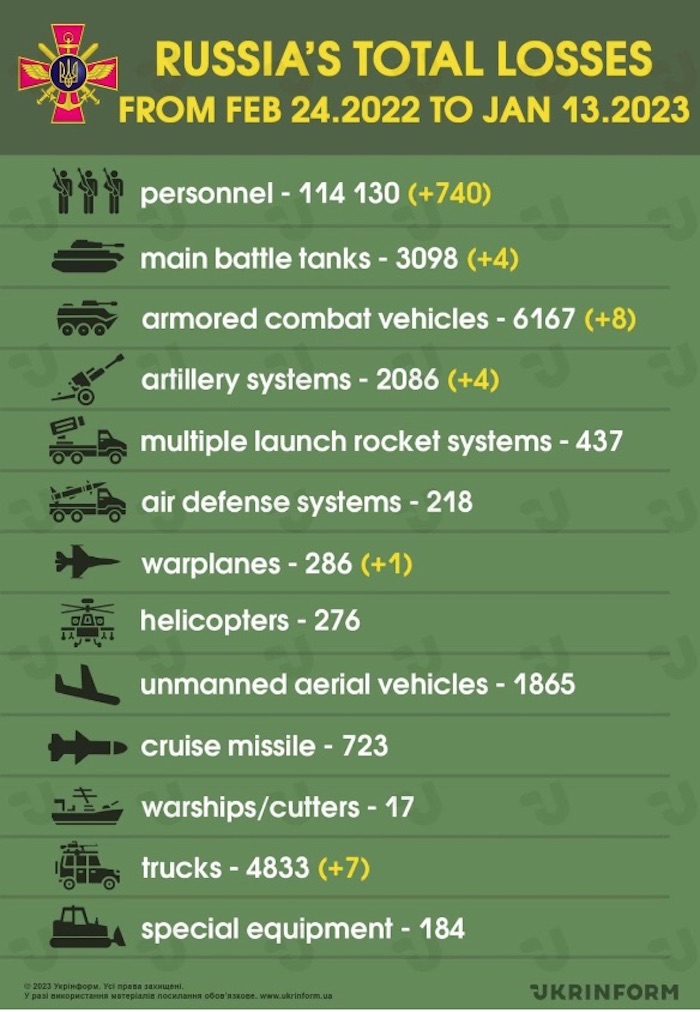
Humanitarian
"Combing the battlefields of eastern Ukraine, a group of volunteers have made it their mission to search for the bodies of fallen soldiers and return them to their families."https://t.co/XafkiPQxxZ
— Euromaidan Press (@EuromaidanPress) January 12, 2023
More than 2.4M Ukrainians live in war-damaged homes, Ukrinform reports, citing Vice Prime Minister for Restoration of Ukraine, Oleksandr Kubrakov. “More than 2.4 million Ukrainians live in damaged or ruined property as of the autumn of 2022. More than 316,000 Ukrainians have already submitted applications for compensation via Diia [digital government service]. And this is far from a full list of those affected, it is updated every day, he noted.
According to Kubrakov, the problem requires a clear state policy. Bill No.7198, which is currently under consideration by the Verkhovna Rada, can become one of the tools for regulating the issue of compensation for destroyed housing. In particular, the law defines who can receive compensation, in what form, when and how the injured party can use it to purchase a new home.
As reported, the Russian aggression has caused more than $700 billion in damage to Ukraine’s economy.”
The effects of trauma from the war with Russia vary widely, with an estimated 75 percent of Ukrainian kids suffering from psychological damage. – by @RFERL's @CurrentTimeTv pic.twitter.com/1Ni4eKzA9T
— Euromaidan Press (@EuromaidanPress) January 12, 2023
Millions of refugees from Ukraine have crossed borders into neighbouring countries, and many more have been forced to move inside the country. The escalation of conflict in Ukraine has caused civilian casualties and destruction of civilian infrastructure, forcing people to flee their homes seeking safety, protection and assistance the UNHCR reports. As of 10 January:
| Individual refugees from Ukraine recorded across Europe: | 7,968,510 |
| Bulgaria, Czech Republic, Hungary, Poland, Republic of Moldova, Romania, Slovakia | 2,440,782 |
| Other European countries | 2,656,209 |
| Russian Federation, Belarus | 2,871,519 |
| Refugees from Ukraine registered for Temporary Protection or similar national protection schemes in Europe: | 4,928,311 |
| Bulgaria, Czech Republic, Hungary, Poland, Republic of Moldova, Romania, Slovakia | 2,435,356 |
| Other European countries | 2,492,955 |
| Border crossings from Ukraine (since 24 February 2022): | 17,408,643 |
| Border crossings to Ukraine (since 28 February 2022): | 9,376,677 |
Environmental
US, Allies Prepare Fresh Sanctions on Russian Oil Industry
Treasury officials are in Europe this week discussing price caps that go into effect next monthhttps://t.co/xJkuXFguhH
— Euromaidan Press (@EuromaidanPress) January 12, 2023
Haidai describes cities in Luhansk Oblast which have “ceased to exist” due to constant fighting, Ukrainska Pravda reports, citing Serhii Haidai, Head of the Luhansk Oblast Military Administration. “The territory of Luhansk Oblast can be roughly divided into three parts: one part was occupied back in 2014, the second part was occupied without heavy fighting after 24 February 2022, and there is a part of the oblast where a line can notionally be drawn from Kreminna: Kreminna, Rubizhne, Zolote, Hirske, Lysychansk and Popasna. The active phase of hostilities has been going on there for four and a half months. Some settlements such as Bilohorivka – although that is not the only one – and the city of Popasna have ceased to exist altogether. As a result of the constant hostilities and attacks, we have had thousands of strikes every day, ranging from mortars to aerial bombs.
All the critical infrastructure there is in ruins. The water supply system has been completely destroyed. The Popasna water utility and all its infrastructure were located near Bilohorivka. The entire water supply system, pumps, compressors, treatment facilities – everything has been destroyed.
The electricity substations have been destroyed. Kreminna’s expensive modern substation, one of the best in Europe, has been destroyed. It was able to meet the demand of the entire oblast.
Everything related to sewerage and gas supply – everything has been strategically destroyed. The occupiers tried to repair it here and there, but that was more for the cameras. After they were connected to the gas supply, houses began to blow up because the infrastructure was damaged.
As for water, there is no water anywhere in the big cities. They even recommissioned the wells, but when there was fierce fighting, a lot of people were killed. No one took the bodies away for a long time. It was summer, it was 32-34 degrees. All these substances from the corpses got into the ground, and people who drank that water started to get sick.”
According to Haidai, there are fewer problems in rural areas due to the autonomy of the infrastructure. However, gathering firewood is difficult. There is not enough, and there are many cases of people being blown up by mines while they were looking for wood.”
Legal
Two effective death sentences in #Russia most savage attack to date on #CrimeanTatar civic #journalists and activists#FreeDzhemilGafarov #Ukraine #LetMyPeopleGo #StandWithUkraine #StopRussia https://t.co/CjTYylkNlD pic.twitter.com/jOCNYlwmTc
— Halya Coynash (@halyapuff) January 11, 2023
Scale of alleged torture, detentions by Russian forces in Kherson emerges, Reuters reports. “The methods of the alleged physical torture administered by occupying Russian forces have included electric shocks to genitals and other parts of the body, beatings and various forms of suffocation, according to interviews with more than a dozen alleged victims, members of Ukrainian law enforcement and international prosecutors assisting Ukraine. Prisoners were also held in overcrowded cells without sanitation or sufficient food or water for periods of up to two months, some of the people said.
Reuters wasn’t able to independently corroborate individual accounts shared by […] Kherson residents but they fit with what Ukrainian authorities and international human rights specialists have said about conditions and treatment during detention, including detainees being blindfolded and bound, subject to beatings and electric shocks and injuries, including severe bruising and broken bones, forced nudity and other forms of sexual violence.
This was done systematically, exhaustingly to obtain information about the Ukrainian military and suspected collaborators or to punish those critical of the Russian occupation, according to Andriy Kovalenko, the Kherson region’s chief war crimes prosecutor.
The Kremlin and Russia’s defence ministry didn’t respond to Reuters’ questions, including about alleged torture and unlawful detentions. Moscow, which has said it is conducting a “special military operation” in Ukraine, has denied committing war crimes or targeting civilians.
According to the most comprehensive figures to date on the scale of alleged torture and detentions, shared exclusively with Reuters by Ukraine’s top war crimes prosecutor, the country’s authorities have opened pre-trial investigations involving more than a thousand people in the Kherson region who were allegedly abducted and illegally detained by Russian forces during their months-long occupation.
The scale of alleged crimes in the Kherson region now emerging appears to be much greater than around the capital of Kyiv, say members of Ukrainian law enforcement, which they attribute to the fact that it was occupied for so much longer.
Ukraine’s top war crimes prosecutor, Yuriy Belousov, said authorities have identified ten sites in the Kherson region used by Russian forces for unlawful detentions. Around 200 people who were allegedly tortured or physically assaulted while held at those sites and about another 400 people were illegally held there, he said. Ukrainian authorities say they expect the figures to grow as the investigation continues following Russia’s mid-November withdrawal from Kherson city, the only regional Ukrainian capital it captured during its nearly year-long war against its Western neighbour.
Nationwide, authorities have opened pre-trial investigations into alleged unlawful detentions of more than 13,200 people, Belousov said. They have launched 1,900 probes into allegations of ill-treatment and illegal detention, he said.
Russia has accused Ukraine of carrying out war crimes and the West of ignoring them, including alleging that Ukrainian soldiers had executed Russian prisoners of war. The United Nations in November said it had found evidence that both sides had tortured prisoners of war, with a UN official saying Russian abuse was “fairly systematic.” Kyiv has previously said it would investigate any alleged abuses by its armed forces. […]
Of more than 50,000 reports of war crimes that have been registered with Ukrainian authorities, Belousov said more than 7,700 have come from the Kherson region. More than 540 civilians remain missing from the region, he added. Some people have been taken to Russian-held territory in apparent forced deportations, including children, according to Kovalenko, the regional prosecutor. […]
Some of the thousands of alleged war crimes committed by Russian forces could be escalated to overseas tribunals if they are deemed sufficiently serious. The Hague-based International Criminal Court (ICC) has opened an investigation into alleged war crimes in Ukraine. The numbers that are emerging on the scale of alleged detentions and torture, “point to widespread and grave criminality in Russian-occupied territory,” said British lawyer Nigel Povoas, lead prosecutor with a Western-backed team of legal specialists assisting Kyiv’s efforts to prosecute war crimes. Povoas said there appears to have been a pattern to inflict terror and suffering across Ukraine, which reinforces “the impression of a wider, criminal policy, emanating from the leadership” to target the country’s civilian population. […] The Kremlin and Russian defence ministry didn’t respond to questions about methods of alleged torture.
Russian stormtroopers disguise themselves as Ukraine’s Armed Forces in east: provocations expected, Ukrainian Pravda reports, citing the press service of National Resistance Center (NRC). “The use of the Ukrainian pixel [a camouflage pattern- ed.] by Russian assault units was recorded on the Kreminna front. The Russians can also plan operations under a “false flag” to discredit the Armed Forces of Ukraine. Demonstrative acts of violence against the civilian population are possible.”
On 10 January, the NRC reported that Russia’s military was planning to attack a hospital in the temporarily occupied part of Luhansk Oblast to discredit the Armed Forces of Ukraine.”
Support
As Poland and Britain weigh sending tanks to Kyiv, pressure on other allies mounts
Poland would require a sign-off from Berlin to send its German-made tanks.https://t.co/iP85KPTb9J
— Euromaidan Press (@EuromaidanPress) January 12, 2023
Pentagon supports allies’ initiatives to provide tanks to Ukraine, Ukrinform reports. “We are absolutely supportive of any type of defense capabilities that our international allies and partners can provide to Ukraine to include tanks, General Patrick Ryder, Press Secretary for the US Department of Defense, said during a briefing at the Pentagon on Thursday, an Ukrinform correspondent reported. According to him, one of the equations considered is the ability to train Ukrainians, sustain and maintain this equipment. In this context, he stressed: We’re going to continue to keep all options on the table, when it comes to the capabilities that we provide to Ukraine.
The Pentagon Press Secretary expressed his belief that this issue will be discussed at the Ukraine Defence Contact Group meeting in Ramstein, Germany, on January 20. At the same time, according to him, the meeting participants will also focus on Ukraine’s air defence capabilities and ammunition supply.
In addition, Ryder said preparations are currently underway for training the Ukrainian Armed Forces units on Bradley fighting vehicles, which will be transferred to Ukraine as part of the latest large-scale package of US security assistance from the United States.
Those [combat] vehicles will go to Germany first so that the Ukrainians can train on them as part of the combined arms and joint maneuver training, the Pentagon representative specified. He noted that the training is expected to begin in Germany next week.
As reported, on January 11, President of Poland Andrzej Duda announced that Poland would hand over a company of German Leopard heavy tanks to Ukraine. Later, President of Finland Sauli Niinistö expressed his readiness also to send Leopard tanks to Ukraine under certain conditions.”
"Britain’s moves toward supplying Ukraine with battle tanks are a headache for Olaf Scholz — but it’s still unlikely that the German chancellor will change his stance on not sending heavy German armor without taking his lead from Washington."https://t.co/taD1Xto61z
— Euromaidan Press (@EuromaidanPress) January 11, 2023
New Developments
https://twitter.com/EuromaidanPress/status/1613284494831767566
- Peace summit may take place in New York on anniversary of full-scale Russian invasion, Ukrainska Pravda reports, citing Vasyl Bodnar, the Ambassador of Ukraine to Türkiye, in an interview with Turkish news outlet Anadolu. “The peace summit that was previously announced by the Ukrainian government may take place at the United Nations headquarters in New York, on 24 February.”
- Ukraine to initiate adoption of UN resolutions on peace formula, Russia’s accountability – Dzheppar, Ukrinform reports, citing First Deputy Minister for Foreign Affairs of Ukraine, Emine Dzheppar. “These are two main resolutions that we will focus our diplomatic efforts this year. Number one step in February – this is peace formula. And the second one will be Russia’s accountability, she said. According to Dzheppar, an extraordinary special session of the General Assembly can be convened to approve the resolution on the peace formula proposed by President Volodymyr Zelensky at the G20 summit, while the resolution on accountability will be considered later this year.”
- Next two or three months to be almost decisive in war – Secretary of National Security Council, Ukrainska Pravda “The next few months will be very important in the war between Russia and Ukraine, and both sides are preparing for a decisive battle, Oleksii Danilov, the Secretary of the National Security and Defence Council of Ukraine, has said.”
- Putin demotes Surovikin, replacing him with Gerasimov as commander of war in Ukraine, Ukrainska Pravda reported on Wednesday, citing RIA Novosti. “Sergei Surovikin was dismissed from the position of commander of the Russian Armed Forces in the ongoing invasion of Ukraine. Valerii Gerasimov, the Chief of the General Staff of the Russian Federation, was appointed to this position, while Surovikin became his deputy. They said that the new assignments are related to “expanding the scale of the tasks to be solved” and the need to organise closer cooperation between the types and branches of the armed forces“.
- Brussels wants to adopt 10th sanctions package by February, Hungary may halt it again, Ukrainska Pravda reports, citing PAP andEuropean Pravda. “Brussels has accelerated work on the tenth package of sanctions against Russia, with EU member state leaders wanting to adopt a new package before the EU-Ukraine summit in Kyiv, scheduled for early February. The adoption of sanctions in the EU always requires unanimity. In this context, some diplomats fear that Hungary may delay the adoption of new restrictions, as it did in the past. The Hungarians have stated they would not agree with some names on the sanctions lists. Further tensions with Budapest can be expected, the EU official said.”
- Ukraine’s MFA Denies That Ukraine Asked Not to Punish Belarus in Latest EU Sanctions Packages, European Pravda “The Ministry of Foreign Affairs of Ukraine has stated that media reports about Ukraine’s alleged request to keep out Belarus from the latest EU sanctions are untrue.”
- Putin ally suggests confiscating property of Russian war critics, Reuters “A close ally of Russian President Vladimir Putin on Friday suggested confiscating property and assets of Russians who discredit the country’s armed forces and oppose the war in Ukraine. Vyacheslav Volodin, the speaker of the Russian Duma, said current measures, such as fines for those who speak out against what Moscow calls a “special military operation” in Ukraine, were not strict enough.”
Twenty-one countries investigating Russia's crimes in Ukraine – Eurojust
The vast majority of investigations are conducted in EU countries. https://t.co/ZD2wA8HaFk
— Euromaidan Press (@EuromaidanPress) January 12, 2023
Assessment
- On the war.
The Institute for the Study of War has made the following assessment as of January 12, 2023:
Russian forces’ likely capture of Soledar on January 11 is not an operationally significant development and is unlikely to presage an imminent Russian encirclement of Bakhmut. Geolocated footage posted on January 11 and 12 indicates that Russian forces likely control most if not all of Soledar, and have likely pushed Ukrainian forces out of the western outskirts of the settlement. The Ukrainian General Staff reported that Ukrainian forces repelled Russian attacks against Sil in Donetsk Oblast—a settlement over a kilometer northwest of Soledar and beyond previous Ukrainian positions. The Ukrainian General Staff and other senior military sources largely did not report that Ukrainian forces repelled Russian assaults against Soledar on January 12 as they have previously. Russian sources claimed that Russian forces are still clearing Soledar of remaining Ukrainian forces as of January 12. Russian milbloggers posted footage on January 12 of Wagner Group fighters freely walking in Soledar and claimed that they visited the settlement alongside Russian forces. The Russian Ministry of Defense (MoD) has not announced that Russian forces have captured Soledar, but Kremlin spokesperson Dmitry Peskov congratulated Russian forces for successful offensive operations in the settlement. All available evidence indicates Ukrainian forces no longer maintain an organized defense in Soledar. Ukrainian President Volodymyr Zelensky’s January 12 statement that Ukrainian forces maintain positions in Soledar may be referring to defensive positions near but not in Soledar.
Russian information operations have overexaggerated the importance of Soledar, which is at best a Russian Pyrrhic tactical victory. ISW continues to assess that the capture of Soledar—a settlement smaller than 5.5 square miles—will not enable Russian forces to exert control over critical Ukrainian ground lines of communication (GLOCs) into Bakhmut nor better position Russian forces to encircle the city in the short term. Russian forces likely captured Soledar after committing significant resources to a highly attritional tactical victory which will accelerate degraded Russian forces’ likely culmination near Bakhmut. Russian forces may decide to maintain a consistently high pace of assaults in the Bakhmut area, but Russian forces’ degraded combat power and cumulative exhaustion will prevent these assaults from producing operationally significant results.
Russian President Vladimir Putin likely seeks scapegoats for the Russian defense industrial base’s struggle to address equipment and technological shortages. Putin publicly criticized Russian Deputy Prime Minister Denis Manturov for aviation industry enterprises not receiving state orders during a cabinet of ministers meeting on January 11. Putin stated that some enterprises have yet to receive state orders for 2023 and are not hiring more staff or preparing to increase output for potential orders in the future. Putin also interrupted Manturov’s explanation that the ministry had already drafted orders for civil and military industries, leading Manturov to admit that Russia had not issued a portion of documents for aircraft manufactures that would approve state funding for their projects. Putin argued that the enterprise directors informed him that they had not received any state orders amidst current “conditions” in Russia and urged Manturov to not “play a fool.” Manturov attempted to soften the demand by stating that the ministry will “try to do everything possible,” to which Putin responded that he should not try his best but instead complete the task within a month. Kremlin Spokesperson Dmitry Peskov later downplayed the altercation as “a normal workflow.”
This incident is likely part of an ongoing Kremlin information campaign to elevate Putin’s image as an involved wartime leader. The Kremlin could have cut out the disagreement from its official transcript (as it often does for most of Putin’s meetings, which are heavily edited and stage managed), but chose to publicize Putin’s harsh response, possibly to identify other officials within the Kremlin as the culprits for Russian defense industrial base’s challenges and possibly to threaten other officials. ISW previously reported that Putin began making more public appearances—including visiting defense industrial enterprises — in December and January, despite previously limiting his engagements throughout the span of the war in Ukraine. Putin is also likely attempting to appease Russian milblogger critiques regarding the lack of advanced military equipment and Russia’s inability to task its defense industrial base to accommodate the war effort. ISW had also previously reported that some private armament manufacturers have criticized the Kremlin for failing to arrange any state contracts with their firms on their Telegram channels, feeding in their critiques into the milblogger discourse.
Manturov’s attempts to soften Putin’s timeline indicate his uncertainty that the Kremlin has the capacity to administer these contracts in a short time period. Manturov tried to explain to Putin that the ministry will authorize additional contracts “based on the opportunities that are formed by the budget, including the preferential program of the National Wealth Fund,” highlighting the differences between the Russian financial reality and Putin’s unrealistic objectives for a short-term revitalization of the Russian defense industrial sector.
Ukrainian intelligence confirmed that senior Russian military leadership is preparing for significant military reforms in the coming year, though ISW continues to assess Russia will struggle to quickly—if at all—implement planned reforms. Deputy Chief of the Main Operational Directorate of the Ukrainian General Staff, Brigadier General Oleksiy Hromov, stated on January 12 that Russian military leadership plans to increase military personnel to 1.5 million (from roughly 1.35 million as of September 2022) and form at least 20 new military divisions in 2023, which Hromov noted indicates “the Kremlin’s intentions to engage in a long-term confrontation and preparations for conducting large-scale hostilities.” Hromov stated that Russia’s significant personnel, weapons, and equipment losses; the effects of international sanctions; and structural weaknesses in the Russian military apparatus have reduced Russia’s force generation capabilities and ultimately raise doubts about whether Russian forces can implement these reforms within undisclosed deadlines. Hromov’s statements come the day after the Russian Ministry of Defense (MoD) announced a major restructuring of the senior command structure for Russian operations in Ukraine and suggest that the Russian military apparatus writ large is engaged in a concerted campaign to reform and restructure multiple tactical, operational, and strategic aspects. ISW has also previously reported that Russian Defense Minister Sergei Shoigu proposed the expansion of the size of the Russian military and the formation of 17 new maneuver divisions at a Russian MoD Collegium in Moscow on December 21, 2022—it is unclear what additional 3 divisions Hromov is referring to. ISW assessed that the Russian MoD has been steadily reversing the 2008 Serdyukov reforms (which sought to streamline the Russian ground forces and move to a brigade-based structure) by restoring maneuver divisions across Russian military districts since 2013, but that the Kremlin is unlikely to implement these reforms on a timeline that is relevant for Russia’s war on Ukraine. Restructuring of senior command structures, coupled with efforts to expand the military base in 2023, suggest that Russia is setting conditions for a long-term, concerted effort in Ukraine. The Russian MoD may also hold highly unrealistic expectations of its own ability to quickly restructure its ground forces.
Key Takeaways
- Russian forces have likely captured Soledar on January 11, but this small-scale victory is unlikely to presage an imminent encirclement of Bakhmut.
- Russian President Vladimir Putin likely seeks scapegoats for the Russian defense industry base’s struggle to address equipment and technological challenges and retains unrealistic expectations of Russian capacity to rapidly replace losses.
- Ukrainian intelligence confirmed that senior Russian military leadership is preparing for significant military reforms in the coming year, though ISW continues to assess Russia will struggle to quickly—if at all—implement planned reforms.
- Russian and Ukrainian forces reportedly continued offensive operations along the Svatove-Kreminna line.
- Russian forces continued offensive operations around Bakhmut, Avdiivka, and west of Donetsk City.
- Russian forces continued defensive operations on the east (left) bank of the Dnipro River.
- Russian officials and occupation authorities may be preparing for the mass deportation of Ukrainian citizens from occupied territories to the Russian Federation.
- Chairman of the State Duma Committee on Defense Andrei Kartapolov announced that Russian military recruitment offices may increase the age of eligibility for conscription as early as this spring’s conscription cycle.
Commander-in-Chief of the Russian Ground Forces, Oleg Salyukov (who was appointed as one of Chief of the General Staff Valery Gerasimov’s three “deputies” as theater commander in Ukraine), arrived in Belarus to take control of combat coordination exercises for the joint Russian-Belarusian Regional Grouping of Forces (RGV).
US Department of State: Any incremental Russian gain will never be able to change tide of war, Ukrinform reports. “Ukrainian forces, with their counter-offensive that started last year, have been extraordinarily effective at halting Russian advances, pushing Russian forces back, recapturing thousands of square miles of territory, and the fact that certain Russian elements are claiming they have made some incremental progress I think speaks to the lack of the Russian ability to make such claims in quite some time, Ned Price, Spokesperson for the US Department of State, said at a briefing on Thursday, an Ukrinform correspondent reported.
At the same time, he noted that the US assesses the situation in Donbas as the continuation of intense fighting. He supposes that both sides will continue to have incremental gains and losses.
But any incremental Russian gain, even one that comes at such heavy cost in terms of casualties and personnel and equipment, will never be able to change this tide of war, the Spokesperson said.”
Russia may repeat massive mixed attack on Ukraine, Ukrainska Pravda reports, citing Natalia Humeniuk, Head of the Joint Press Centre for Operational Command South. “Russia is likely preparing to conduct a massive hybrid attack on Ukraine in the near future, using missiles and Iranian-made drones. Presumably, such an attack is being prepared, because the intervals of preparation of the occupiers’ troops are exactly the same: they need about 10-12-14 days to reorganise after the [previous] massive attack they carried out on the territory of Ukraine.
Humeniuk explained that Russia’s stockpile of missiles is already exceeding the limit of their inviolable stockpile, so they might use “mixed practices”. In addition, she believes that the Russians are concerned about the quality of Ukrainian air defence, so they are trying to use “wave-like tactics” to identify air defence positions and attack them as well. Humeniuk also noted the increased activity of Russian reconnaissance aircraft.”
Russians plan to capture Donbas and then take over Zaporizhzhia Oblast, Ukrainska Pravda reports, citing Brigadier-General Oleksii Hromov, Deputy Chief of the Main Operational Directorate of the Ukrainian General Staff. “The General Staff of the Armed Forces of Ukraine expects that in the near future, Russian troops will try to capture the entire territory of Donetsk Oblast, and then try to occupy part of Zaporizhzhia Oblast.
The General Staff also predicts that the invaders will continue to carry out air strikes on critical infrastructure facilities throughout Ukraine. Hromov added that in order to implement its plans to capture Ukraine, Russia has announced large-scale measures to reform the armed forces – in particular, to increase the total number of troops to 1.5 million military personnel and to form at least 20 new divisions.
The General Staff believes that these actions by the Russian Federation testify to the Kremlin’s intentions to engage in a long-term confrontation and their preparation for large-scale hostilities. The main goal of Russian forces remains the capture of the entire territory of our country and the destruction of the statehood of Ukraine, Hromov concluded.”
Commander of Ukraine’s Joint Forces does not see threat of repeated attack from Belarus, Ukrainska Pravda reports. “Lieutenant General Serhii Naiev, Commander of the Joint Forces of the Armed Forces of Ukraine, assures that Belarus does not have enough troops for a new ground invasion of Ukraine. As of today, the situation on the territory of Belarus does not pose a direct threat of any ground action against Ukraine.
Naiev states that Ukraine maintains contact with western partners, in particular, with the US and Poland, and Ukraine’s intelligence is also constantly working. The received information indicates that the grouping of Belarusian troops along the border with Ukraine currently “has not changed either quantitatively or qualitatively”.
The US [Department of Defense] sees no signs that Belarus is preparing to enter the war against Ukraine, despite its participation in joint military drills with the Russian Federation. On Monday, Russia and Belarus are planning joint drills for aviation units, which will take place on the territory of Belarus. The drills are planned to take place from 16 January to 1 February, with the involvement of Russian and Belarusian forces.”
Russia building up aviation grouping in Belarus – Ukraine’s General Staff, Ukrinform reports, citing Brigadier General Oleksii Hromov, Deputy Chief of the Main Operational Department of the Ukrainian General Staff. “Under the guise of holding joint military exercises, the Russian armed forces will soon deploy a Russian grouping of troops in Belarus, which can be used for aggressive actions against Ukraine. […] The potential threat of an offensive by the Russian armed forces from Belarus will remain in place throughout the year, Hromov said. He noted that at this moment, no measures have been observed that Russian forces is forming a strike grouping to resume offensive operations from Belarus.
Currently, Russian forces has intensified railway transportation along the state border of Ukraine and is moving their units to Belarus to restore their combat capability. In addition, units of the [Russian] armed forces, which have been conducting combat coordination on Belarusian training grounds since October 2022, are being moved from Belarus. Hromov said that Belarus had extended the ban on flights of civilian aircraft over its territory until April 1, and Russia is building up its aviation grouping in Belarus.
In Belarus, restrictions on flights of all types of civilian aircraft, including UAVs, in the south of the country, including in the Brest and Gomel regions bordering Ukraine, have been been extended until April 1. At the same time, the Ministry of Defense of Belarus announced the holding of joint flight and tactical exercises of the air component from both states in the period from January 16 to February 1 of this year. Under the guise of conducting the specified exercises, Russian forces is building up an aviation grouping in Belarus. Last week, at least ten Mi-8 and Mi-24 helicopters were moved to the Machulishchy airfield. It is also expected that operational and tactical aircraft will be relocated to the Belarusian airfield. Flights of long-range aircraft of the aggressor country in the Belarusian airspace are not excluded, Hromov said, adding that given the above, the threat of airstrikes and the use of kamikaze drones against Ukraine from the Belarusian airspace is increasing.”
- Consequences and what to do?
There’s an increasing amount of articles in Western media speculating about Russia’s collapse and disintegration, Kristi Raik, Deputy Director ICDS Tallinn, wrote yesterday. She argued that “collapse and disintegration are not necessarily the same thing. I’ve written about collapse, meaning the collapse of the current regime and (perhaps) system, but this does not need to lead to Russia disintegrating into pieces – although it may. Second, post-imperial Russia to some (incl. myself) means Russia that no longer seeks to dominate its neighbours. To others, it means also the disintegration of the Russian Federation, with colonised minorities establishing their own states. Again, one may lead to the other – or not.
Third, should the West actively promote regime collapse, regime change or even the disintegration of Russia? I’d say the Western focus has to be on defeating Russia in Ukraine and denying it the right to a sphere of influence. What kind of system will emerge in Russia consequently is something the Russians need to figure out themselves. Western ability to influence Russia’s domestic developments is very limited.
One of the achievements of the whole debate is that the Western public is becoming aware of Russia’s colonial practices, which are just as deplorable and brutal as the colonial practices of some Western countries used to be. The difference is that Russian colonialism continues.
Some commentators are enthusiastic about the prospect of Russia’s collapse and/or disintegration, while others are fearful. I think it’s better to avoid being either. Certainly, there are risks involved in Russia’s collapse, but we should be far more afraid of Russia’s victory in Ukraine and the devastating consequences it would have for European security at large than Russia’s defeat and possible subsequent regime collapse.
One can no longer say that very few are predicting Russia’s disintegration – as was the case with the collapse of the Soviet Union. In fact, there are so many people predicting it that it has become kind of trendy. But whether it is likely to happen is another matter. What is more likely is Ukraine’s victory, which would lead to the collapse of Putin’s regime. This is increasingly seen as a real possibility in the West, provided that military aid to Ukraine is further stepped up. The West must not constrain its support to Ukraine out of fear of Russia’s collapse.”
“Violence Is Part of Russian Mindset, Not Many Understand That”. Interview with Russian-German Expert, European Pravda reports. The following is an extract from an interview with Sergei Sumlienny, born and raised in Russia but today a German citizen having given up his Russian passport. He works in Berlin and heads the European Resilience Initiative Center. While he discusses the German attitude, I suspect that this reflects the mindset found in most of “Old NATO” and all those who still a diplomatic solution is possible. Russia only respects strength and military power.
“German politicians are frightened by the thought of Russia’s defeat in the war because they cannot comprehend it. “What will happen after?” They cannot imagine Russia’s defeat, let alone a defeat that will end up with Russia’s collapse. Germans are scared even to think about it. So it is better not to think about it.
The opposite outcome, like “reconciliation” with Russia, is welcome by many.
First, they cannot imagine how the Ukrainian nation, which for many Germans “did not exist” until recently, wins a war against a nuclear state. Secondly, they cannot realise that the crimes committed by the Russian military in Ukraine are actually part of the Russian political worldview. They do not realise how much Russians do support such actions.
It was easier for me to understand the actions of Russians in Ukraine because I was born in Russia and socialised there. I didn’t doubt that Russia would attack Ukraine. I understood that destroying Ukraine is a fundamental value of Russian statehood.
In general, for a normal person, and even more so for a German, it is terrifying to understand who the Russians are as a political community. Russian worldview is violence which is a top of values. Not wealth, not health, not fun, but violence itself is their basic value.
The history of Russia “taught” Russians that power is useless, money is useless, life is useless. Today you are Stalin’s People’s Commissar, and tomorrow you are “in the basement.” Today you are an oligarch, and tomorrow you drink polonium in your tea.
That is why the cult of war, disguised as the cult of victory, is so popular there. They honour Victory Day not because they saved their country. The idea of victory for the Russians is that “we destroyed everyone. Our tanks marched across Europe.” Russians also have a cult of sexualised violence, including the “We Can Do It Again” car stickers, where two human figures are depicted in a position that apparently implies violence and rape. Victory for them is when you rape someone. Likewise in the current war.
Ukrainians see victory when their country is saved, and there are no more threats. Russians see victory when they enter the city, burn everything, rape, and move on. Destroying something is even better for them than stealing. They demonstrate their power in such a way. “To steal” is not so relevant because today you have it, and tomorrow someone will steal it from you.
Moreover, very educated Russians fully share this concept of cannibalism – representatives of business, science, and culture integrated into the Western world. They see nothing wrong in destroying Mariupol or Kyiv, striking a nuclear attack on Ukraine, in those created in Russia filtration camps, in torture…
But the Germans do not see this. They cannot imagine that this is possible. The Germans cannot believe it is about Russia’s desire to physically destroy the Ukrainian nation and turn those who remain alive into Russians.»
Hans Petter Midttun: Many articles and analyses on the potential fall, collapse and disintegration of the Russian Federation have emerged recently. It marks a huge shift from 324 days ago when so many expected Ukraine to do the same within days. Having witnessed the second-strongest army in the world collapse on the battlefield due to a combination of bad leadership, poor intelligence and planning, lack of combined arms and joint manoeuvre, flawed command and control, faulty logistics, bad technical designs, poor level of training, and much more, the table has turned.
There seems to be a general consensus that a Russian defeat in Ukraine means the end of Putin’s regime. Few analysts, however, are expecting Russia to emerge as a democratic country in the aftermath of the defeat. Quite the opposite, the potential scenarios range from a radicalisation of its current form to a collapse and disintegration altogether.
Ironically, several high-ranking (retired) Russian officers warned President Putin of this outcome in the months and weeks leading up to the full-scale invasion.
Colonel-General Leonid Ivashov, 78, wrote a letter titled “The Eve of War” in which he attacked Putin’s policy of provoking a war despite Russia not facing any critical threats. He feared that the use of military force against Ukraine, firstly, would call into question the existence of Russia itself as a state; secondly, it would forever make Russians and Ukrainians mortal enemies. In addition, he argued that Russia would be included in the category of countries that threaten peace and international security, would be subject to the heaviest sanctions, would turn into a pariah of the world community, and would probably be deprived of the status of an independent state.
Ivashov was supported by retired FSB general Yevgeny Savostyanov, stressing that there is no sane scenario for an attack on Russia by Europe. He warned against an invasion of Ukraine, stressing that big losses would come immediately.
They were not the only critical Russian voice at the time. Many academics signed a letter arguing that:
“Russia does not need a war with Ukraine and the West. Nobody threatens us, nobody attacks us. A policy based on promoting the idea of such a war is immoral, irresponsible and criminal, and cannot be carried out on behalf of the people of Russia. Such a war can have neither legitimate nor moral goals. The diplomacy of the country cannot take any other position than the categorical rejection of such a war. The war not only does not correspond to the interests of Russia but also carries a threat to its very existence.”
Their predictions have come true, and the Russian Federation might be facing an existential challenge – not from the West – but from the consequences of its own aggressions.
Having the world’s largest nuclear arms arsenal, a collapse or disintegration raises fears similar to what we experienced in the 90s after the collapse of the Soviet Union.
The strategic environment, however, is entirely different. Three decades ago, the collapse didn’t occur as a consequence of a full-scale war in Europe. In contrast to today, the confrontation between the East and West was in the process of de-escalation before its final collapse. Today, we are witnessing an increasingly belligerent Russia mobilising society for “an existential battle” (as a consequence of its aggressions). Additionally, the West quickly stepped in to help Russia from disintegrating. That’s unlikely to happen today. Its demise is partly a result of the West cutting its ties with the country. Lastly, in the 90s China was not a global power. The balance of power between Russia and China has changed fundamentally in the favour of the latter during the last decades. Today, Russia is increasingly dependent on China.
In the article The Fall of Russia, Bruno Tertrais argues that Putin’s neo-imperial project is collapsing and proposes three (near-)certainties and four scenarios.
First certainty: Russia in the mid-2020s will be a country undermined by military, economic (sanctions) and demographic weakening (more than 500,000 people have already left the country).
Second certainty: the country is separating from Europe. {…] The Mongol and Tatar heritage of Russia will take a more important part in the national culture.
The third certainty is that after the war, Russia will enter a troubled period. We know the history of the country: military debacles are often followed by political upheavals, as we saw in 1905, 1917 or 1989.
As for the scenarios, the least unfavorable one would be that of Germany after 1945. After the Götterdämmerung, the Stunde Null of which ensued shock and trauma, then followed by introspection and healing. But Russia does not have the rule of law tradition (even with interruptions) that Germany had at the time. […]
More likely, then, is the North Korean scenario: the isolation and radicalization of a fortress-Russia, in which Putin or his successors would keep the country’s population in a permanent state of war. French expert Françoise Thom speaks of an “autarkic empire” that would wean the population away from Western influence. […]
A step further in the pessimism scale, Russia would become (for those who are most worried) a kind of Mordor (“black country”), a desolate land in which the forces of evil are preparing their revenge and reconquest of Middle Earth. The country’s descent into barbarity is already at work […]. An exaggeration? Not really, if you realize that for the past ten years, Russia’s best and brightest brains have left and, increasingly, so as its middle classes. But Russian society has become criminalized “groups have taken over mafia rules, borrowing from them a lifestyle, physical attitudes, a sui generis ‘morality’, a hierarchy formed by ‘godfathers’ ruling over their protégés“. […]
The Somalian scenario would also be that of the breakup of the Russian nation-empire. […] As has been pointed out, the Russian empire, given the distances between the core and the periphery, actually resembles its European counterparts of the past. Could Russia survive the collapse of the national myth fostered by Moscow, that of a tutelary nation superior to others and destined to control its neighbours?”
Its nuclear power remains a constant in all of these scenarios. As does the Western concern for Russia’s future.
This is, however, where the potential future meets the present realities. I have repeatedly argued that the outcome of a Russian victory in Ukraine is utterly unacceptable to the West.
There are only two alternatives. Either a Russian or a Ukrainian victory. All notions, dreams or fantasies of a “compromise” only exist in the minds of those who don’t understand Russia and Ukraine.
Putin’s regime – not Russia – is fighting for its existence. Its decision to invade Ukraine, however, has put the very existence of Russia at risk. Ukraine – both the country and the nation – is fighting for its existence.
The West, in contrast, is still deliberating on what to do. It is not yet providing Ukraine with the tools it needs to win in the fear of a Russian defeat while seeing a Russian victory as utterly unacceptable.
The West must not constrain its support to Ukraine out of fear of Russia’s collapse.





